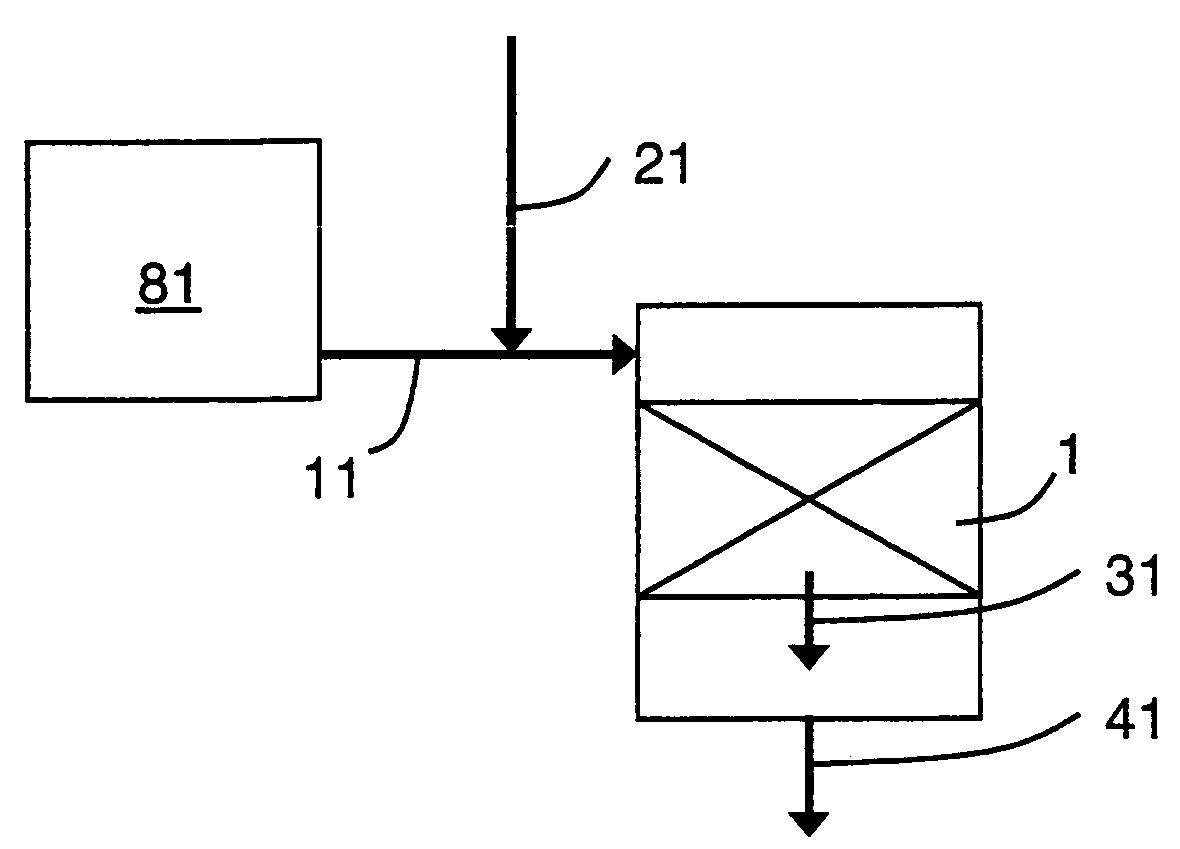Method and apparatus for the production of hydrogen-rich gas
a technology of hydrogen-rich gas and process, which is applied in the direction of lighting and heating apparatus, machines/engines, and separation processes, etc., can solve the problems of large temperature rise across the shift reactor, affecting steam consumption, and the reaction rate of iron oxide catalysts at low temperatures is comparatively slow, so as to prevent over-reduction of the shift catalyst
- Summary
- Abstract
- Description
- Claims
- Application Information
AI Technical Summary
Benefits of technology
Problems solved by technology
Method used
Image
Examples
example 1
Base Case
[0073]The base case has one catalyst region, similar to FIG. 1, but without the oxidative stream 21. The base case serves as a basis for comparison for efficiency improvement and over-reduction. For the base case, the reformer feed stream has a steam to carbon (steam-to-carbon) ratio of 3. The reformer effluent, which is the gaseous feed stream 11 to the shift reactor has a CO / CO2 ratio of 1.61 and a steam-to-dry-gas ratio of 0.54. The thermal efficiency of H2 production will be normalized with the thermal efficiency of the base case, giving a value of 1 for the base case.
[0074]With a feed to the reformer having a steam to carbon ratio of 3, the primary criterion to prevent over-reduction of catalyst, CO / CO2≦1.61, is satisfied.
example 2
Reduced Steam and No Oxidative Stream
[0075]There is incentive to reduce the amount of steam to the catalytic steam reformer. This improves the overall efficiency of the process.
[0076]Example 2 has one catalyst region, similar to FIG. 1, but without the oxidative stream 21. The reformer feed stream has a reduced steam to carbon ratio of 2.5. In this case the reformer effluent, which is the gaseous feed stream 11 to the shift reactor has a CO / CO2 ratio of 1.86 and a steam-to-dry-gas ratio of 0.46. The normalized thermal efficiency is calculated to be 1.015, a 1.5% improvement over the base case, thereby illustrating the incentive to reduce the steam-to-carbon ratio to the reformer.
[0077]But in this case, neither criterion for preventing over-reduction of the catalyst is satisfied. The CO / CO2 ratio is 1.86, which is greater than the maximum 1.61, and the steam-to-dry-gas ratio is 0.46, which is less than the minimum 0.6.
example 3
Oxidative Stream from Shift Reactor Product Stream
[0078]Example 3 has one catalyst region, similar to FIG. 1, with the oxidative stream 21. The reformer feed stream has a reduced steam to carbon ratio of 2.5. In this case the reformer effluent, which is the gaseous feed stream 11, is blended with an oxidative stream 21, which in this example is a slipstream of the product stream 41 from the shift reactor, after being cooled considerably, but still above the dew point, to facilitate recycle compression. The molar ratio of stream 21 to stream 11 is 0.085. The blended stream to the shift reactor then has a CO / CO2 ratio of 1.61. The normalized thermal efficiency is calculated to be 1.014, a 1.4% improvement over the base case.
[0079]In this example, the primary criterion for preventing over-reduction of the catalyst is satisfied. A similar thermal efficiency improvement to example 2 is provided while keeping the catalyst in a safe regime.
PUM
| Property | Measurement | Unit |
|---|---|---|
| molar ratio | aaaaa | aaaaa |
| temperatures | aaaaa | aaaaa |
| temperature | aaaaa | aaaaa |
Abstract
Description
Claims
Application Information
 Login to View More
Login to View More - R&D
- Intellectual Property
- Life Sciences
- Materials
- Tech Scout
- Unparalleled Data Quality
- Higher Quality Content
- 60% Fewer Hallucinations
Browse by: Latest US Patents, China's latest patents, Technical Efficacy Thesaurus, Application Domain, Technology Topic, Popular Technical Reports.
© 2025 PatSnap. All rights reserved.Legal|Privacy policy|Modern Slavery Act Transparency Statement|Sitemap|About US| Contact US: help@patsnap.com



